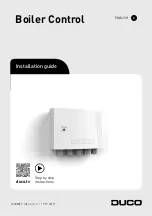
P2_PANTHER_user manual_ work basis_EN_03 - 07/11 - Protherm
- 25 -
HOW TO USE THE BOILER
8.17.12 Safety measures
The distance of
fl
ammable materials from
the exhaust component of the separate
piping must be enough to ensure that
the temperature at the surface of these
materials is no higher than 80°C.
Exhaust may not be vented in areas:
• where a danger of explosion is present
(as set forth in STN 33 2320)
• that are interior areas of a building
(lofts, halls, stairwells etc.)
• closeable, i.e. passages or gateways
etc.
• that descend underground (even if
these remain open to the surroundings
and free of obstructions), e.g. tunnels,
underpasses etc.
These basic injunctions for venting
exhaust must always take adequate
account of where independent air intakes
are sited.
Wall apertures for coaxial piping for
drawing in air and venting exhaust are
cut to the appropriate size (approx. 120
to 150 mm) and sealed (with building
construction methods) following the
installation. Non-
fl
ammable materials (with
Degree A of
fl
ammability according to STN
73 0823) must be used for sealing, e.g.,
masonry mortar, plaster etc. Openings in
combustible walls or roofs must be made
according to the
fi
rst section of this part.
8.18 Connecting the boiler to the
electricity supply
Hooking up the boiler to the mains voltage
is done through a triple-wire plug with a
fl
exible cord. The socket for connecting
the boiler to the electrical network must
comply with STN 33 2000-4-46. It must
always have the protective ground (pin)
reliably connected with the PE or PEN
wire (a combination of green and yellow
colours). The boiler must always be
connected through its main to the ground
and must always be installed in a way that
allows access to the socket and plug. The
use of a variety of “adaptors”, “extension
cords” etc. is not permitted.
Caution:
The preparation of plugs
and sockets as well as room regulator
connections that extend into the interior
electrical components of the boiler must
under all circumstances be carried
only by a person with electrotechnical
quali
fi
cations as set forth in Decree No.
50/1978 Coll. In the same way, servicing
of the electrotechnical components
may be carried out only by a person
with the above-mentioned professional
quali
fi
cations. Before servicing the
electrotechnical elements the boiler must
be disconnected from the current by
pulling the mains lead from the socket!
The main body of the boiler is protected
by a tube fuse (T 2A / 250 V), which is
located on the boiler control board.
For regulating the boiler from a room
regulator, only a regulator that has a no-
voltage input, i.e. that does not send any
external voltage into the boiler, may be
used.
Load carrying capacity of the regulator
with a relay switch is 24V / 0.1 A.
The room regulator must be connected
to the boiler with a two-wire plug. The
recommended cross-section for the room
regulator connection (copper lead) is 1.5
mm
2
.
Leads for connecting the room regulator
may not be coaxial with the mains voltage
leads.
The terminal for hooking up the room
regulator with the relay switch is supplied
















































